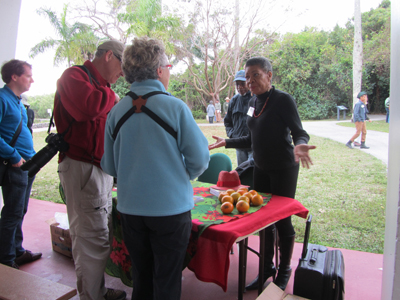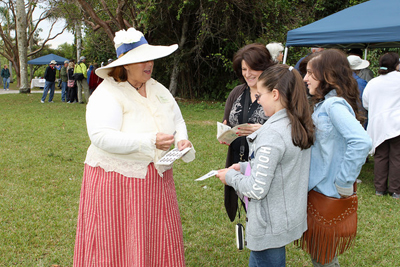
Parks work to improve visitor diversity
The image of the American melting pot unifying all Americans into one culture has vanished from the American psyche and transformed into the image of a salad bowl, with each culture adding their distinct flavor.
Minorities now make up about 35 percent of the population in the United States, an increase of 5 percent from 2000. Hispanics grew by 3.1 percent to 48.4 million, Asians increased 2.5 percent to 13.7 million, and blacks, who make up about 12.3 percent of the population, increased less than 1 percent last year to 37.7 million, according to the 2010 census.
However, there is one place this drastic change in demographics is not reflected- the National Park Service.
 |
Author and president of Earthwise Productions, Audrey Peterman (right), speaks with visitors at the Everglades National Park’s Vintage Day event. Peterman spoke about the importance of diversity in the national parks and why all people, especially minorities, should visit the parks (Photo by Ashley Martinez). |
According to a 2009 National Park Service Comprehensive Survey of the American Public, which queried 4,103 respondents across the U.S., non-Hispanic whites comprised 78 percent of park visitors in 2008–2009. By comparison, Hispanics accounted for 9 percent of visitors, while African-Americans were 7 percent of visitors.
“Our country looks a lot different today than when the national parks were created, but unfortunately, a lot of the visitors don’t look very different than they did 100 years ago,” said Amy Marquis, National Parks Conservation Association associate editor of “National Parks.” “I think things are changing, but the fact that this is still a topic means we’re not there yet.”
When looking into the reasons why minorities are not frequent visitors to the national parks, history is one of the contributing factors, according to Audrey Peterman.
Peterman is the president of Earthwise Productions, author of “Legacy on the Land: A Black Couple Discovers our National Inheritance and Tells Why Every American Should Care,” and spends her time educating people about the need to share the national parks with everyone, especially minorities.
Peterman says a large reason these groups do not visit national parks is because as late as the 1960s, people of color were barred by law from certain places, including national and state parks.
“Lots of times people say, ‘We don’t understand why people don’t come to the parks’ and I’m like, when have you done anything to invite people?” Peterman said. “Have you done anything that really says that there is a break between then and now? Have you done anything that shows the people that their stories are in the parks, their histories are in the parks, and the parks are available to them? No? Then why are you surprised that they are not here?”
People from all over the world come to the international gateway of South Florida to make a home in the United States. Everglades National Park Ranger Rudy Beotegui experiences first-hand the journey of those people, because his mother came to the United States from Argentina.
“From my conversations with my mom, I guess a lot of minorities in South Florida might be more focused on making it as opposed to recreating,” Beotegui said. “The focus is different than someone with their roots here, or anywhere, in the U.S. for many generations. That’s one part of the issue; there are a lot of different folks from South Florida, it’s kind of hard to tell some of them ‘Hey, spend your Saturday in the Everglades’ when they could be working.”
The growth of minorities is nothing unique to Florida, but is happening all over the country, and is mostly being felt in the Southwestern U.S., especially in California, which holds a large Asian community and where Hispanics make up over 50 percent of the population.
| Park Ranger Ivy Kelley portrays Mary Barr Munroe at the Everglades National Park’s third annual Vintage Day. Volunteers and Park Rangers dressed up as 28 historical characters who interacted with visitors to tell the story of the people who helped shape the Everglades (Photo by Glenn Gardner). |  |
Shelton Johnson, a Yosemite National Park Ranger, has worked to bring awareness of the history of the Buffalo Soldiers, an African-American regiment of the military who served as some of the first park rangers in the Sierra Nevadas in 1899.
Johnson believes people need to recognize that many ethnic groups helped shape the parks, something that is not known to many cultures who do not have a history of park attendance.
“Part of it is cultural awareness, asking has anyone in the community done this before, how did you hear about it?” Johnson said. “We are reaching out more fully to African-Americans, Hispanics, Asians, to make them aware that the parks exist and that we celebrate these cultures.”
Located in the Yosemite Visitor Centers are exhibits showcasing the contributions of communities of color to the national parks. This serves as a way to educate people, who may not know all the contributions these groups have made, Johnson said.
Parks all throughout the country are adding Spanish subtitles to their visitor orientation films, hiring bilingual park rangers, and celebrating events such as Hispanic Heritage month.
Another obstacle facing minorities is the lack of information. Many people do not know of the national parks or have heard rumors that keep them away since they believe the parks to be unsafe.
One way of bringing knowledge is by the outreach and “in reach” programs put on by rangers like Beotegui.
One program at the Everglades National Park is called C.A.M.P., Camping Adventures with My Parents. The program brings middle school students who have never been exposed to camping in the park to the Everglades for the weekend. By involving the student’s parents, rangers hope families will realize what a positive experience it is and will be motivated to come back and share with more people.
To expand the reach of the program, a Spanish version of C.A.M.P. also took place. The main goal is to look for people who have never been to the park, and it always seems to be minorities, Beotegui said.
Efforts are being made throughout parks to reach out to Spanish speakers by making all the signs in both English and Spanish. This, coupled with the educational programs, is attracting people to experience the beauty of the parks.
“I think that a lot of people, from an ethnicity standpoint, it was not that it was a situation of not feeling welcome but I just think that this wasn’t part of their culture,” said Kirk Singer, seasonal interpretive ranger at Everglades National Park. “Now, especially with the education program, I think it probably starts there, the environmental education program is a huge deal. I think kids go home and maybe tell their parents and then they come. I think it’s been a big deal”
Idalmis Santana and her daughter, Alessandra Puig-Santana, visit the park every weekend to enjoy the trails as well as support Puig-Santana’s brother, a park ranger. The pair tries to encourage their friends and family to join them whenever they can in the hopes of introducing them to the park they love.
“One day, we came to the Anhinga trail early in the morning when all the birders were there looking for birds and, we’re a loud Cuban family, so we were so loud the alligators started bellowing, and you don’t see that this season, and all the birders were freaking out,” Puig-Santana said.
The overall goal of avid supporters and those involved with the National Park Service will always be to get people, no matter who they are, to the parks that were set aside for the enjoyment of the American people.
“In the historic parks, we have the opportunity to learn of the contributions that each ethnic group has made to the development of our country,” Peterman said. “When you are in the presence of that gigantic, indescribable thing, you just feel the sense of awe, the sense of oneness, the sense of belonging to something so much bigger than yourself. You feel the differences of race and class and all the artificial separation that man puts up amongst ourselves, those things just dissipate, and you have just won with that. That is why I am so passionate about the national parks.”
If You Go:
What: Everglades National Park
Where: 40001 State Highway 9336, Homestead, Fla. 33034
Hours: 9 a.m.- 5 p.m.
Phone: 305-242-7700

Comments are Closed